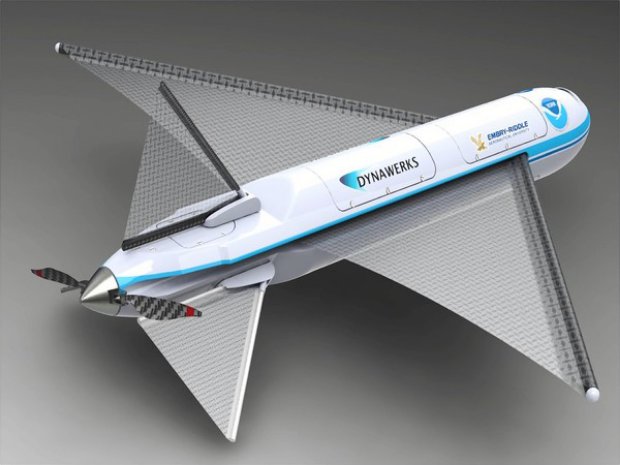The National Oceanic and Atmospheric Administration, in partnership with Embry-Riddle Aeronautical University, has developed GALE, its own unmanned aircraft. Measuring 3 feet long and weighing 8 pounds, the $30,000 unmanned aircraft is made of hard composites and powered by an electronic motor. It cruises at about 55 mph and can stay aloft for about 1.5 hours before falling into the ocean, never to be used again.
It will be launched from the belly of a hurricane hunter turboprop, initially shot out of a tube as a cylinder. Then it will sprout wings and fly into the core of a hurricane, where it will feed wind speeds and other atmospheric data into computer models that project a storm’s track and strength.
“It gives us a better understanding of how the ocean is interacting with the atmosphere,” said Joe Cione, project leader with the National Oceanic and Atmospheric Administration. “Right now, the models are guessing at what’s going on down there.We’re going to be pretty much out in the middle of nowhere when we deploy these,” Cione said. The first one will be flight-tested in coming weeks; then two of them will be flown into two separate hurricanes next year. Pilots based on the ground will control them via satellite link, Cione said.
Initially, it will be dropped into the eye of a hurricane, where the winds are usually calm, said Massood Towhidnejad, a professor of software engineering at Embry-Riddle. It will remain there, collecting data, until it is almost out of power. Then it will be directed into the hurricane’s eye wall, where the winds are tumultuous. At that point, the tiny plane will become uncontrollable, Towhidnejad said. “We’re basically hoping this thing will last as long as it can,” he said. “The wind forces will take over and cause it to rotate. But that’s exactly what we want.” That violent rotation, he said, will become another means to determine a storm’s strength and structure.
While the hurricane center has dramatically improved track forecasts, it has made little progress with intensity forecasts. That’s because forecasters haven’t been able to detailed information about the inner workings of the eyewall, said specialist James Franklin. “This device has the potential to gather data we can’t typically get,” he said. “If the aircraft can successfully linger in the hurricane eyewall at very low levels, that would be an exciting advance.” Still, it’s too early to know how much of an impact GALE will have on the “intensity forecast problem,” he said.
It won’t be the first time an unmanned aircraft has investigated tropical systems. A similarly small plane, called an Aerosonde, was first flown into Hurricane Ophelia in September 2005, when it was threatening North Carolina. More recently, a Global Hawk turbine-powered aircraft, designed to stay aloft more than 30 hours at high altitude, was deployed into some of last year’s storms.
Source: The Sun Sentinel


Interesting, one of the most natural tasks for a UAV`s,
Ref. “D-D-D concept”.
Also many nice links on your web side.